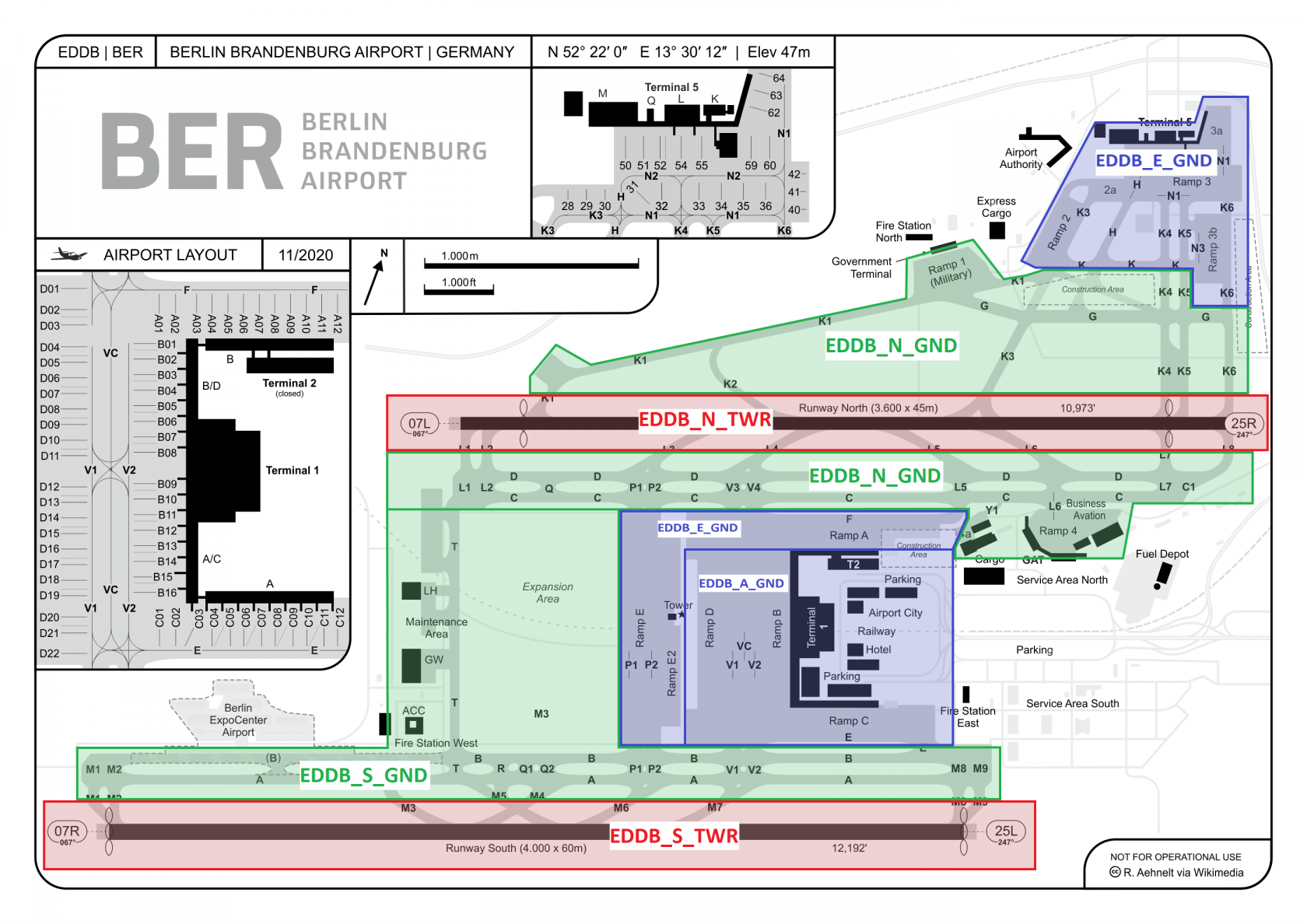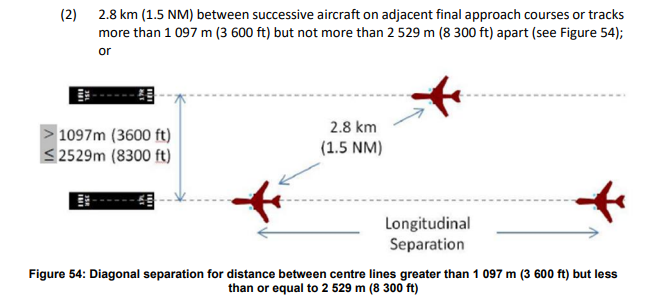Tower
Stations and AoRs
| Station |
Station ID |
Frequency |
Login |
| Berlin Tower Nord |
DBTN | 120.030 |
EDDB_N_TWR |
| Berlin Tower Süd | DBTS | 118.805 | EDDB_S_TWR |
If both Tower are online, the CTR is divided into two AoRs with a border between the runways. In case Ground is offline, Tower will cover this station.
General
Modes of operation
Berlin Airport is authorized for the following modes of operations:
| Mode |
Spacing between 07L/25R and 07R/25L |
| Dependent Parallel Approaches | 1,5 NM (*) |
| Independent Parallel Approaches | --- |
| Independent Parallel Departures | --- |
| Segregated Parallel Operations | --- |
(*) 1,5 NM diagonal separation may only be used when Berlin Director is online (this does not need to be coordinated with Tower). In case only Berlin Arrival is online, a 3 NM diagonal separation must be used instead!
Dependent Parallel Approaches
Dependent Parallel Approaches may be used whenever Berlin Director is online.
REQUIREMENTS AND PROCEDURES FOR DEPENDENT PARALLEL APPROACHES
- separate air traffic controller is responsible for the sequencing and spacing of arriving aircraft to both runways
- the final approach course or track is intercepted by use of:
- vectoring; or
- a published arrival and approach procedure that intercepts with the IAF or the IF.
- the instrument flight procedure that aligns the aircraft with the extended runway centre line is a precision approach
- aircraft are advised that approaches are in use to both runways;
- a minimum of nominal 1000 ft vertical separation or a minimum of 3.0 NM horizontal separation is provided between aircraft until established on the final approach courses or tracks of parallel approaches
- the minimum horizontal separation to be provided between aircraft established on the same final approach course or track is 3.0 NM unless increased longitudinal separation is required due to wake turbulence;
- the minimum horizontal separation to be provided diagonally between successive aircraft on adjacent final approach courses or tracks is:
Source: Regulation (EU) 2017/373, ANNEX IV — Part-ATS
Independent Parallel Approaches
During periods of high traffic, independent parallel approaches may be used.
REQUIREMENTS AND PROCEDURES FOR INDEPENDENT PARALLEL APPROACHES
The main responsibility of Berlin Tower is to monitor the approach area between 14 NM and the threshold. In case of any deviation from the LOC, the traffic on the adjacent LOC shall be turned immediately!
"Turn left/right(number) degrees/heading(three figures) immediately to avoid traffic *deviating from adjacent approach*, climb(level)."
In order to perform independent parallel approaches, both director and tower positions have to be staffed.
During Independent Parallel Approaches, both Tower need to activate the NTZ between both runways.
SUSPENSION OF INDEPENDENT PARALLEL OPERATIONS DUE TO METEOROLOGICAL CONDITIONS:
The meteorological conditions to be considered include, but are not limited to, the following:
- wind shear;
- turbulence;
- downdrafts; and
- crosswind and significant meteorological conditions such as thunderstorms, which might otherwise increase deviations from the final approach course or track to the extent that safety may be impaired.
Source: Regulation (EU) 2017/373, ANNEX IV — Part-ATS
Independent Parallel Departures
Independent parallel departures shall always be used, except if the following requirements are not met:
REQUIREMENTS AND PROCEDURES FOR INDEPENDENT PARALLEL DEPARTURES
- Parallel runways may be used for independent instrument departures as follows:
- both runways are used exclusively for departures (independent departures) or
- one runway is used exclusively for departures while the other runway is used for a mixture of arrivals and departures (semi-mixed operation) or
- both runways are used for mixed arrivals and departures (mixed operation).
- Independent IFR departures should only be conducted from parallel runways when the conditions listed below are met:
- both aircraft are flying an RNAV or RNP instrument departure and
- the turn commences no more than 2.0 NM from the departure end of the runway
- a suitable ATS surveillance system capable of identification of the aircraft within 1.9 km (1.0 NM) from the end of the runway is available
- ATS operational procedures ensure that the required track divergence is achieved.
In case departing traffic deviates from the departure route, the responsible tower controller needs to create separation immediately.
Note: Vectored and visual departures are not approved for independent parallel departures
SUSPENSION OF INDEPENDENT PARALLEL OPERATIONS DUE TO METEOROLOGICAL CONDITIONS:
The meteorological conditions to be considered include, but are not limited to, the following:
- wind shear;
- turbulence;
- downdrafts; and
- crosswind and significant meteorological conditions such as thunderstorms, which might otherwise increase deviations from the final approach course or track to the extent that safety may be impaired.
Source: Regulation (EU) 2017/373, ANNEX IV — Part-ATS
Segregated Parallel Operations
In Berlin, segregated runway operations will be used during the following conditions:
- Low Visibility Procedures
- Suspension of Independent Parallel Departures (e.g. due to CB, wind shear, turbulence, downdrafts, strong crosswind)
- Special regulation of traffic flows (e.g. shuttle event)
For Berlin the following runway configurations are preferred for segregated parallel runway operations:
- 07-Operations: 07L departures, 07R approaches
- 25-Operations: 25L departures, 25R approaches
REQUIREMENTS AND PROCEDURES FOR SEGREGATED RUNWAY OPERATIONS
Segregated parallel operations should only be conducted on parallel runways when the following conditions are met:
- the nominal departure track diverges immediately after take-off by at least 30 degrees from the missed approach track of the adjacent approach
- the instrument flight procedure that aligns the aircraft with the extended runway centre line is one of the following
- precision approaches or RNP approach
- visual approach
- precision approaches or RNP approach
Source: Regulation (EU) 2017/373, ANNEX IV — Part-ATS
Target Spacing
The responsible approach controllers will use the following target spacings depending on the conditions:
| Conditions |
Target Spacing |
| Departures expected | 6 NM |
| No departures expected | 3 NM |
| Low Visibility Operations | 5 NM |
Note: Tower may ask the approach control to increase the target spacing in case traffic has to depart between approaching aircraft. Usually, the Berlin approach unit will take the situation of departing traffic on the ground into account.
As long as possible, Tower may use reduced runway separation to depart traffic between approaching traffic. Due to the mixed operations on both runways, Berlin Tower must use every gap sufficient for departing traffic.
Departing traffic
Departure Separation
The following departure separation shall be used, except if wake turbulence separation is higher:
| Conditions |
Separation |
| Same SID following | 5 NM |
| Different SID following | 3 NM |
Handoff
Departing Traffic will be transferred to Berlin Departure when established on the SID. The following frequencies shall always be used if APP or DEP are staffed:
- Traffic departing runway 07L/25R: Bremen Radar - 120.340 (Departure Nord)
- Traffic departing runway 07R/25L: Bremen Radar - 120.630 (Departure Süd)
Intersection Departures
On the following intersections, Berlin Tower shall ask if traffic is in sight when using conditional clearances:
- Runway 07L: L3, L4, K2
- Runway 07R: M3, M5
- Runway 25R: L5, L6
- Runway 25L: M6, M7
Arriving traffic
Separation on final
- After the transfer of communications from Director, Tower is responsible for monitoring the separation between arriving aircraft. If necessary Tower shall also use methods to ensure separation on the final.
- When traffic is inside the EDDB D(CTR) (below 2500 ft), Berlin Tower may adjust the speeds of aircraft on final without prior coordination. If this is done, Tower is solely responsible for separation to traffic behind, on the same final.
Handoff
If Berlin Ground is staffed, traffic will switch to Ground automatically when vacated. This procedure shall be broadcasted in the ATIS.
VFR traffic
Control zone
 CTR Berlin - © openflightmaps.org
CTR Berlin - © openflightmaps.org
VFR Procedures
- VFR movements preferred via runway 25R/07L
- Crossing of the airport as to be coordinated between both Tower controllers
EDAZ traffic
IFR traffic inbound to EDAZ will momentarily enter Berlin D(CTR). Bremen Radar is responsible to inform Berlin Tower about every IFR approach at EDAZ.


